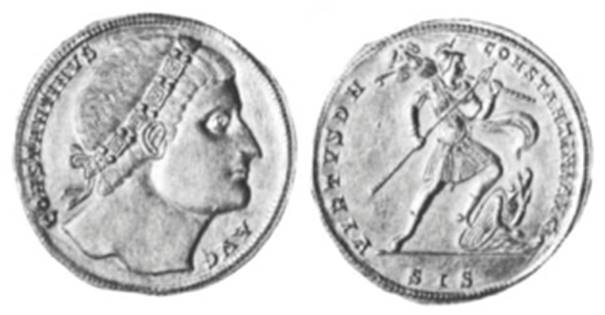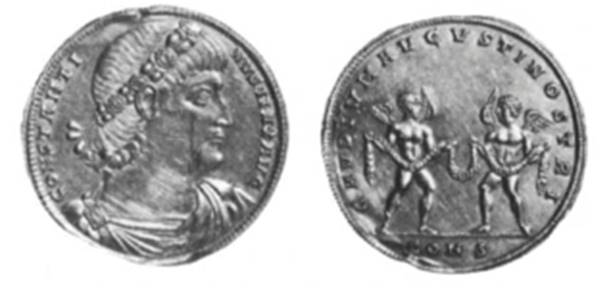Medallion of Constantine I. Siscia, Yugoslavia, 325-326. Gold
obv: Constantin vs AVG(ustus). Head of Constantine facing right and looking upward, wearing diadem of square jewels separated by pairs of pearls, with a round jewel in front.
rev ; virtvs D(omini) N(ostri) const antini AVG(usti). Constantine in helmet and armor walking right and spurning a seated captive in Eastern dress; the emperor carries a spear in right hand and a trophy over his left shoulder. In exergue, sis(cia)

This medallion was struck at the mint of Siscia in what is now Yugoslavia; it is part of a large series produced for the celebration of Constantine's vicennalia in 326. It is chiefly remarkable for its portrayal of the emperor in an upward- gazing pose. The historian Eusebius remarked of this type: "The deep impression made by Divine Faith upon his soul may be perceived from the fact that he ordered that he be portrayed on the gold coins looking upward, intent upon God, in an attitude of prayer" [Vita Constantini 4.15). Modern historians have adduced Alexander the Great as the prototype for this posture; it recalls the divinely inspired Hellenistic ruler, whose upward gaze symbolized the inner contact between the earthly ruler and heavenly powers.
Though the medallion was struck in connection with the vicennalia, the military reverse type alludes to Constantine's victory over Licinius in 324, by which he secured control of the East.
This piece was found at Semlin, Hungary, in the nineteenth century and was formerly in the Pierpont Morgan collection. Bibliography: Baldwin, 1921, pp. 6ff.; Bellinger, 1958, no. 7.

Medallion of Constantine I. Constantinople, 326. Gold. OBV: CONSTANTIN vs MAx(imus) AVG(ustus). Bust of Constantine facing right wearing diadem of rosettes and laurel leaves and paludamentum fastened with jeweled brooch.
rev: gavdivm avgvsti nostri. Two genii facing each other holding a garland of flowers. In exergue, coNS(tantinopolis)
Date added: 2025-07-10; views: 147;
